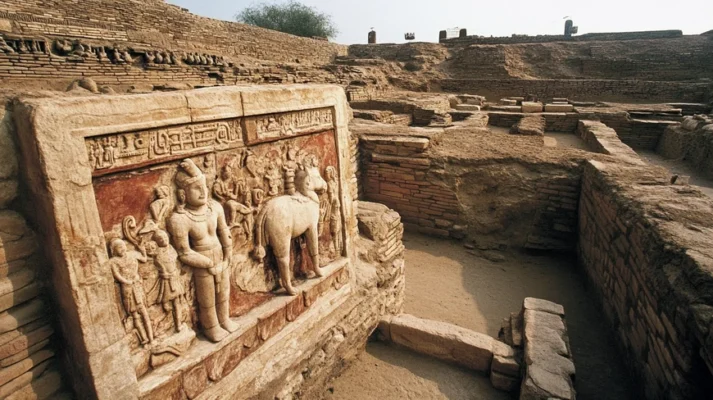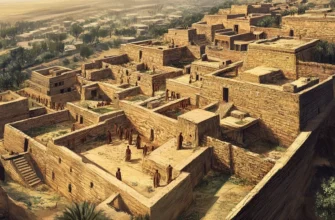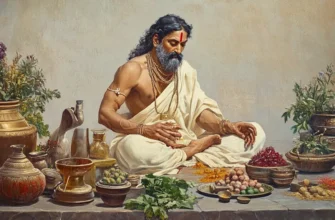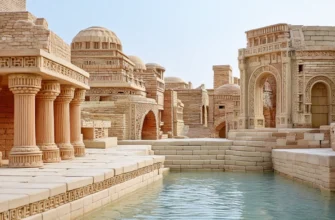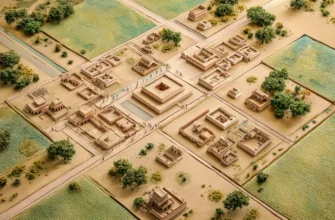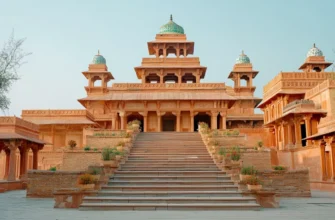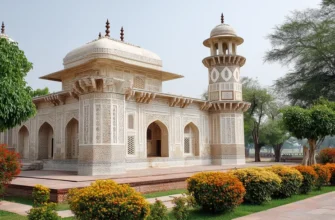The Harappan civilization, which flourished in what is now Pakistan and India around 2500–1900 BCE, left a significant mark on the cultural and religious development of humanity. Religious beliefs were deeply integrated into the daily life of its inhabitants and manifested themselves through various rituals, ceremonies, and symbols.
The main element of religion was the belief in the forces of nature, in particular in deities who controlled water, fertility, the earth, and animals. One of the most famous figures is the statue of a god with horns, depicted on numerous artifacts. Scientists suggest that this was a deity associated with the animal world and natural cycles.
Religious rituals were very important in the life of the Harappans. They performed purification rites and sacrifices, and also had holidays accompanied by music and dancing. Among the archaeological finds are numerous seals with religious symbols of a magical nature.
Artifacts found in the Harappa area, including statues, seals, pottery, and wall paintings, show a deep understanding of the divine in everyday life. This also points to a close connection between religion and culture, where every aspect of life had a sacred meaning. The absence of large temple complexes suggests that religious practices were more concentrated in households and open spaces, which was typical of agrarian civilizations.
Thus, the religious beliefs of the Harappan civilization played an important role in shaping its culture and social structure. They influenced art, architecture, social relations, and left a deep mark on the history of ancient civilizations.
- The significance of religious beliefs for culture
- The foundations of the religious beliefs of the Harappan civilization
- Worship of natural forces and gods
- Religious rituals and celebrations
- Archaeological finds and religious symbols
- Statues and images of gods
- Description of the main artifacts
- The influence of religious beliefs on culture and social structure
- Conclusions
The significance of religious beliefs for culture
The significance of religious beliefs for culture is a key factor in shaping the social, artistic, and moral aspects of civilizations. Religion often embodies ideas about the world, its creation, the meaning of human life, and our relationship with the divine. These beliefs have influenced all areas of life:
Social structure: Religion determined the rules of interaction in society, as well as the relationship between different classes and groups. In many cultures, religious teachings were the basis for legislation, moral norms, and even political structures.
Art and architecture: Religious beliefs stimulated the development of art, particularly in the creation of temples, sculptures, paintings, and literature. For example, in the Harappan civilization, religious symbols were depicted on seals and statues, reflecting the importance of gods in the life of that culture.
Ceremonies and rituals: Religion contributed to the development of numerous rituals and holidays that had great social and cultural significance. They not only reflected beliefs, but also united communities, strengthened social ties, and upheld moral values.
Morality and ethics: Religious teachings shaped ethical ideas that influenced people’s behavior. They defined what was good and bad and established rules for interacting with other people and nature.
In general, religious beliefs not only determined people’s spiritual quests, but also created the basis for the formation of many cultural and social practices that left a significant impact on the development of civilizations.
The foundations of the religious beliefs of the Harappan civilization
The foundations of the religious beliefs of the Harappan civilization were closely linked to natural forces and the worship of deities that governed various aspects of life. The Harappans probably had a pantheon of gods that was centered around nature, agriculture, and fertility. Although the religion of this civilization has not been fully studied due to the limited number of written sources, archaeological finds allow us to draw some conclusions about the main elements of their beliefs.
Worship of nature and natural forces: The Harappans considered natural elements to be important forces that governed life. They paid particular attention to water, the fertility of the land, and animals. Rivers, particularly the Indus, were of great religious significance as they ensured the fertility of the land and served as the basis for agriculture.
Horned god: One of the key religious images of the Harappan civilization is a statue of a horned god found on numerous seals. Scientists suggest that this god personified the forces of nature and the animal world, possibly associated with animals such as the bull, which symbolized strength and fertility.
Animal worship and symbols: Animals such as bulls, elephants, and tigers were depicted in religious artifacts as symbols of various deities and natural forces. This also indicates that the beliefs of the Harappans were deeply integrated with the surrounding world, where animals played an important role in rituals and the worship of deities.
Religious rituals and ceremonies: The Harappans probably performed religious rituals in open spaces rather than in temple complexes. This included purification, sacrifice, and worship of deities in the form of statues or religious symbols.
The rituals were intended to maintain harmony between people, nature, and deities. Mythology and symbolism: Archaeological finds, such as seals with religious symbols, reflect the presence of mythological ideas about the creation of the world and the interaction of gods and humans among the Harappans.
Mythology was probably an important part of religious beliefs, although most of this context remains undeciphered due to the lack of written texts.
In general, the religious beliefs of the Harappan civilization were closely linked to natural phenomena and the desire of people to ensure the stability and prosperity of their community through interaction with deities, natural forces, and animals.
Worship of natural forces and gods
The worship of natural forces and gods in the Harappan civilization was an important part of religious life, as the inhabitants of this culture viewed nature as the fundamental force that determined their existence.
Natural elements such as water, earth, air, sun, and animals had sacred significance and were associated with religious beliefs. Here are some key aspects of this cult:
Water as a sacred element
Rivers, particularly the Indus River, were the basis of life for the Harappans. Water not only supported agriculture but also played an important role in religious practices. It is believed that the Indus River and other water sources were considered sacred because they provided fertility and life.
The cult of fertility and agriculture
The earth was the main source of sustenance, providing crops, so the cult of fertility was an important element of the Harappan religion. Gods associated with natural forces and ensuring crops were probably key figures in the religious pantheon. They were honored through rituals associated with agriculture and the cycle of plant growth.
Animal gods
Animals held a special place in the religion of the Harappans, often serving as sacred symbols or even deities. One of the most famous images is a horned god resembling an animal, particularly a bull or other large mammal. This may have symbolized strength and fertility. In addition, various animals, such as elephants, tigers, and pigs, may also have been objects of worship or symbols of deities.
Goddesses of fertility and protection
In the Harappan religion, there were probably goddesses who personified motherhood, fertility, and protection. These figures were often associated with the cycle of birth and growth. Their worship helped to ensure the well-being and prosperity of communities.
Sacred symbols and rituals
Symbols reflecting their belief in natural forces played an important role in the religious practices of the Harappans. Numerous seals and artifacts depict animals, deities, and magical symbols, which were probably used for ritual purposes. These symbols were meant to protect people from evil spirits and bring good luck.
Sacred places
Places for religious practices could be either open areas or natural formations (such as special mountains or water sites) that were considered sacred because of their natural beauty or special properties. The absence of large temples may indicate that religious rituals were mostly performed in more intimate and natural settings.
Thus, the cult of natural forces and gods was the basis of the religious life of the Harappans, where every element of nature, be it a river, an animal, or the earth, was perceived as part of the divine order, and through worship, people sought to ensure the well-being of their civilization.
Religious rituals and celebrations
Religious rituals and celebrations in the Harappan civilization were important for the social and spiritual spheres of life. The Harappans performed religious rites, which were probably aimed at ensuring prosperity, fertility of the land, and harmony with the forces of nature.
Although archaeological sources do not provide a detailed description of these rituals, studies of the finds allow us to draw certain conclusions about the nature of religious practices in the Harappan civilization.
Purification and sacrificial rites
One of the key aspects of the religious practices of the Harappans probably included purification rituals, which were intended to ensure the purity and well-being of both individuals and the community as a whole. Sacrifices, particularly of animals, may have been part of these rituals to appease the gods and tame the forces of nature. Natural elements such as water were often used in purification rituals, as rivers were of great religious significance.
Holidays related to the cycle of nature
Celebrations probably took place in accordance with natural cycles, such as the changing seasons or stages of the agricultural calendar. For example, holidays may have been timed to coincide with planting or harvesting, reflecting the importance of agriculture to the Harappans. These holidays may have included dancing, musical performances, animal sacrifices, and other rituals intended to improve the harvest and ensure the fertility of the land.
Deity worship and animal worship
Animal worship played an important role in religious rituals, as animals were considered sacred symbols or even deities. For example, the worship of a horned god, who probably symbolized animals such as bulls, may have been accompanied by special rituals in open areas or natural sanctuaries. Animals could also be sacrificed in rituals to appease deities and bring good luck.
Magical practices and the use of symbols
Religious rituals were probably accompanied by magical practices involving various symbols and amulets designed to protect people from evil spirits or bring good luck. Seals with religious symbols found during archaeological excavations were probably used for such rituals. These symbols could be present on objects worn by people or used during ceremonies.
Places for religious rituals
The Harappan civilization did not have large temple complexes, indicating that religious rituals may have been performed in open areas or in specially designated places. These could have been natural shrines built of stone or other materials where people gathered to perform rituals.
The religious role of women
Women probably played an important role in religious rituals, especially in connection with the worship of fertility goddesses. Women may have participated in rituals symbolizing the renewal of life cycles, birth, and fertility, which corresponded to the main aspects of the religious beliefs of the Harappans.
Thus, the religious rituals and celebrations of the Harappan civilization were an important part of the spiritual life of the community, linked to agricultural cycles, natural forces, and the worship of deities and animals. They were intended to maintain harmony in society, ensure harvests and prosperity, and strengthen social bonds among community members.
Archaeological finds and religious symbols
Archaeological finds and religious symbols of the Harappan civilization are important sources for understanding the religious beliefs and practices of this ancient society.
Since written sources are virtually non-existent, archaeological artifacts, including statues, seals, pottery, and other objects, serve as the main evidence of the religious beliefs of the Harappans.
Seals and religious symbols
One of the most significant archaeological finds are seals depicting religious symbols and deities. Seals were widely used to mark goods and documents, but they often feature complex scenes involving animals, deities, and symbolic images. One of the most famous images is a god with horns resembling animal figures, such as a bull, which probably symbolized strength, fertility, and natural forces.
Statues of gods and animals
There are numerous statues depicting deities or sacred animals that played an important role in religion. For example, one of the most famous statues is that of a woman considered to be the goddess of fertility, with distinctive female features emphasizing the importance of motherhood and birth in a religious context. In addition, statues with horns have been found, indicating the worship of animals, particularly the bull, which is associated with life forces and fertility.
Pottery and tableware with religious images
Some everyday items, such as pottery and tableware, also contain religious symbols. These may be images of animals or ritual motifs that indicate the significance of these items in religious ceremonies. Tableware with symbols of fertility, animals, or deities was probably used during festivals and rituals.
Magical amulets and protective symbols
Other artifacts, such as amulets, may have had magical or ritual significance. They were probably used to ward off evil spirits or to attract good luck. These amulets may have contained religious symbols that were believed to give their wearers special powers. Some amulets were shaped like animals or mythical creatures, again emphasizing the importance of natural and magical imagery in religious practices.
Architectural finds
Although the Harappan civilization did not have large temple complexes, such as those found in ancient Egypt or Mesopotamia, archaeologists have found open shrines and specially equipped places for religious rituals. These places may have been used for ceremonies related to the worship of natural forces and deities. Important finds also include places for sacrifices and ritual fires.
Images on walls and other objects
On some objects, such as clay tablets or other objects, images of worship scenes can be found, confirming the role of religion in social life. These images may include people performing rituals or images of deities participating in religious activities.
Mythological and religious scenes
In addition to specific deities, some archaeological finds contain scenes that can be interpreted as mythological scenes. These may be images of natural cycles, interactions between humans and deities, or animals. For example, scenes involving a bull or other sacred animal may indicate a belief in natural cycles, rebirth, or a symbolic struggle between good and evil.
Thus, the archaeological finds of the Harappan civilization — seals, statues, pottery, amulets, and other objects — provide a deeper understanding of the religious beliefs of this society. The symbols and rituals depicted in these finds testify to the important role of nature, animals, and deities in the religious life of the Harappans.
Statues and images of gods
Statues and images of gods in the Harappan civilization are among the most important archaeological finds that allow us to study the religious beliefs and cults of this ancient society. Although most of the religious practices of the Harappans remain unknown due to the lack of written sources, statues and images of deities provide insight into their ideas about divine powers and the role of religion in their lives.
God with horns
One of the most famous images is that of a god with horns, which appears on numerous seals and statues. This god probably embodied forces of nature, such as animals or natural elements. His images often feature horns, reminiscent of a wild bull or other animal, symbolizing strength, masculinity, and fertility. The horned god was probably an important deity associated with the earth and animals, which had sacred significance for the Harappans.
Statue of a woman with colored jewelry
Another significant find is a statue of a woman believed to be a goddess of fertility. This statue depicts a female figure with distinctive features emphasizing her sexual characteristics, symbolizing fertility and motherhood. It is one of the classic examples of religious images associated with fertility and natural cycles. Your appearance testifies to the importance of women in religious beliefs, emphasizing their role in creating and sustaining life.
Gods and sacred animals
In the religious practices of the Harappans, large animals such as bulls, elephants, tigers, and others were often associated with deities or used as sacred symbols. For example, the bull was probably associated with the cult of fertility and fecundity. Statues and images of animals may symbolize divine power that brings good luck, ensures a harvest, or protects against evil forces.
Mythological images
In addition to statues of individual deities, archaeologists also find mythological scenes depicting interactions between gods and humans or animals. These scenes may indicate rituals, ceremonies, or important moments from religious myths. For example, scenes of worship or sacrificial rituals may have reflected the religious customs of the Harappans, particularly during celebrations of agricultural cycles or natural changes.
Ritual figurines and amulets
Small ritual figurines and amulets depicting deities or sacred symbols were also found in the Harappan civilization. These objects were probably used in everyday life as symbols of protection or well-being. They may have had magical significance to bring good luck or protect their bearers from danger, evil spirits, or disease.
Images on seals
Other archaeological finds include religious images on seals containing various symbols, animals, and deities. Seals were important not only as practical tools for marking goods, but also as objects that performed magical or ritual functions. Some seals depict scenes related to worship, promises of harvest, or other aspects of religious practice.
Images on walls and tiles
In addition, some archaeological excavations have uncovered images on walls or tiles that may be parts of larger religious scenes or narratives. These can be simplified scenes of religious rituals or more complex mythological images explaining the interaction between deities and humans.
Statues and images of gods in the Harappan civilization reflect the importance of nature, animals, and fertility in religious beliefs. Through these archaeological finds, we can understand that the beliefs of the Harappans were closely linked to natural cycles, agriculture, and harmony with the surrounding world. They worshipped gods and animals that embodied the forces of nature that ensured their well-being and prosperity.
Description of the main artifacts
The main artifacts of the Harappan civilization play an important role in studying their daily life, religion, technology, and culture. Since the Harappan civilization left few written sources, archaeological finds help to reconstruct its social structure, religious beliefs, and way of life. Here are some of the main artifacts found during excavations:
Seals and clay tablets
Seals with various images, such as animals, gods, mythological scenes, and symbols, are among the most famous artifacts of the Harappan civilization. They were used to mark goods or as magical objects. The seals usually depict a horned god, sacred animals, and scenes that probably had ritual or magical significance. Clay tablets with relief inscriptions, probably of administrative significance, are also important artifacts.
Statues and ritual figurines
Many statues and ritual figurines have been found in the Harappan civilization, including images of women representing goddesses of fertility and motherhood. These images often have distinctive figures that emphasize female sexual characteristics, symbolizing fertility and the reproduction of life. Some of these statues are quite detailed, allowing conclusions to be drawn about the cult of fertility and the role of women in religious beliefs.
Pottery and clay products
Clay pottery is one of the most common artifacts. They had various shapes and purposes, ranging from ordinary vessels for storing food and water to special ritual vessels that were probably used for ceremonies and sacrifices. Many of them have ornaments or images that may have religious significance. For example, some clay vessels have symbols that probably represent the worship of deities or animals.
Tools and technical artifacts
The Harappans made various tools, such as knives, axes, awls, and weaving tools. They used bronze, copper, and even iron to create technical artifacts, demonstrating a high level of technological skill. For example, looms and presses for making fabric are examples of how the development of crafts influenced people’s daily lives.
Magical amulets
Numerous amulets and talismans have been found at excavation sites, and they probably had magical or ritual significance. Amulets often took the form of animals or deities and could be used to protect against evil forces or to attract good luck.
For example, amulets in the form of bulls or other sacred animals indicate the importance of these images in the religious beliefs of the Harappans.
Toys and children’s items
Some toys and children’s items have also been found during archaeological excavations. These may be small animal figurines, which probably had not only a playful but also a ritual significance. Toys made of clay testify to cultural traditions and social ties within the community, as they probably helped children learn social roles through play.
Miniature animal figures
Miniature animal figures made of stone, ivory, or clay are another type of artifact that testifies to the beliefs of the Harappans. Animals often had symbolic meaning — they could be associated with fertility cults and also used as amulets or ritual objects.
Urban planning
The Harappans left behind well-planned cities, indicating a high level of social organization. Archaeologists have found remains of water supply and sewage systems, which are also important artifacts that demonstrate a high level of engineering and attention to sanitation.
There were also underground water reservoirs and drainage channels in urban areas, indicating thoughtful urban planning and a desire to use natural resources efficiently.
The main artifacts of the Harappan civilization, including seals, statues, pottery, tools, magical amulets, and other items, help us better understand not only the daily life of this civilization, but also its religious beliefs, social structures, and technological achievements. The study of these artifacts is key to reconstructing the culture of the Harappans, as many aspects of their lives remain unknown without this material evidence.
The influence of religious beliefs on culture and social structure
The influence of religious beliefs on the culture and social structure of the Harappan civilization was enormous, as religion permeated all aspects of this culture, from art and rituals to political organization and social relations.
Although many aspects of the religious life of the Harappans remain a mystery due to the lack of written sources, archaeological data allows us to reconstruct important features of the influence of religion on the culture and social structure of this civilization.
Religion as the basis of social hierarchy
In the Harappan civilization, religious beliefs probably played an important role in shaping the social order. Religious rituals and worship of deities were likely carried out through priests, who had high social status. This suggests that the social hierarchy was partly based on religious activity. Higher authority may have been linked to religious legitimacy, where rulers and other important figures would have had special connections with deities or priests who gave them spiritual legitimacy.
Religious practices and public rituals
Religious rituals were probably performed as part of public ceremonies or rituals that brought together different segments of the population.
For example, sacrifices and rituals related to fertility and harvest could be important not only for agrarian life but also for community cohesion. Such rituals helped strengthen social ties between people and created cultural traditions that united different social groups.
Urban planning and religion
Religious beliefs also had a major influence on the urban planning of the Harappan civilization. Cities often had ritual centers, probably temples or places of worship where religious ceremonies were held.
Archaeological excavations indicate the presence of large structures that may be related to cult practices. Special places for religious rites and cults served as centers of religious and cultural life, where people gathered for communal prayers, rituals, or celebrations.
Religious symbols and art
Religion also had a strong influence on art and cultural symbols. Images of deities, animals symbolizing natural forces, and various ritual objects reflected the importance of religion in everyday life.
Religious symbols were used not only in ritual contexts, but also as amulets or talismans for protection and good luck. Art served as an important tool for transmitting religious ideas and beliefs to future generations.
The influence of religion on agriculture
Religious beliefs had a major influence on agriculture, as the worship of fertility deities and natural forces was an integral part of rituals related to sowing and harvesting.
Religious rituals were probably intended to ensure good harvests, protect against natural disasters, and maintain balance in nature. Thus, religion influenced agriculture not only through rituals, but also through the formation of rules and calendars that regulated the agricultural cycle.
Social cohesion through religious customs
Religion also helped to unite the community by bringing people together around shared beliefs and rituals.
Participation in religious ceremonies such as sacrifices, festivals, or other ritual practices contributed to the formation of a common cultural identity. This could strengthen social bonds and maintain peace and harmony in communities, which is especially important for large and complex societies such as the Harappan civilization.
It has been suggested that religious rituals and connections to deities may have had a direct influence on the political system. Rulers may have had religious legitimacy, deriving their power through divine appointment or through an alliance with religious authorities. This may have strengthened their authority and ensured stability in society.
The upper caste group probably also had access to religious and sacred knowledge, which reinforced their position in society. Religious beliefs had a significant influence on the culture and social structure of the Harappan civilization.
They shaped social ties, determined political structures, and influenced agriculture, urban planning, art, and daily life. Thanks to religious practices and beliefs, society was able to maintain stability and unity, which helped the Harappans prosper for centuries.
Religion and everyday life Religion and everyday life in the Harappan civilization were closely intertwined, and religious beliefs permeated almost every aspect of their lives. From agriculture to social practices, religion influenced all areas of life, creating a foundation for organizing society and ensuring harmony between humans and nature. Since the Harappan civilization left few written sources, most of the information about its religious life comes from archaeological finds — temples, seals, statues, and ritual objects.
Conclusions
The study of the religious beliefs and culture of the Harappan civilization allows us to understand how important religion was for the organization of society and the lives of the people of this civilization. Religious beliefs permeated all spheres of their life: from agriculture to social relations, art, and everyday practices.
Archaeological finds such as statuettes, seals, ceramics, and the remains of religious buildings allow us to partially reconstruct religious practices, although many aspects of religion remain unknown due to the lack of deciphered written sources. However, it is clear that religion was not only the basis for rituals, but also determined many social and economic aspects, influencing all aspects of the Harappans’ lives.
Religion had a huge impact on the culture of the Harappan civilization. It influenced social organization, forming a hierarchy in which priests and religious leaders played an important role. Divine patrons could confirm the legitimacy of power, which contributed to stability and unity in society. In addition, religious beliefs deeply influenced art, where images of deities and natural forces not only served an aesthetic function but also served as a means of expressing religious ideas.
Religion also had a significant impact on agriculture through rituals and ceremonies aimed at ensuring harvests and harmony with natural forces. It was also an integral part of everyday life, where religious practices shaped habits, traditions, and social ties among people. Thus, religion became the foundation of the cultural and social structure of the Harappan civilization, ensuring its development and the preservation of traditions through many generations.
